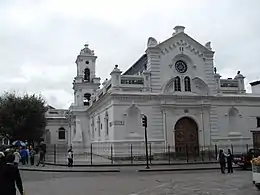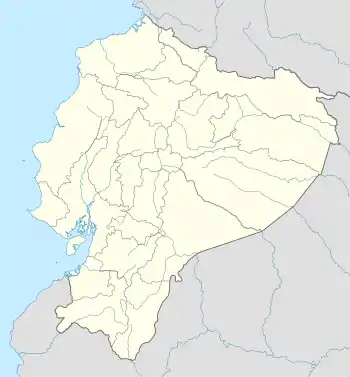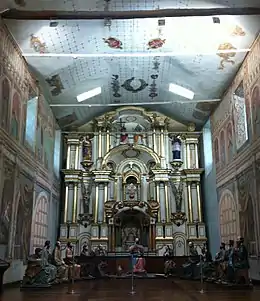Old Cathedral of Cuenca
The Church of the Shrine (Spanish: Iglesia del Sagrario) — commonly referred to as the Old Cathedral of Cuenca (Spanish: Catedral Vieja de Cuenca) — was the main place of Spanish worship during the time of Spanish colonization in Cuenca, Ecuador. It functions today as the Museum for Religious Art and is located at the Parque Calderon, opposite the New Cathedral.
| Church of the Shrine Iglesia del Sagrario (in Spanish) | |
|---|---|
 | |
| Location | |
| Location | Cuenca, Ecuador |
 Shown within Ecuador | |
| Geographic coordinates | 2.897837°S 79.00385°W |
| Architecture | |
| Type | Basilica |
| Style | Baroque |
| Groundbreaking | 1567[1] |
| Part of | Historic Centre of Santa Ana de los Ríos de Cuenca |
| Criteria | Cultural: (ii)(iv)(v) |
| Reference | 863 |
| Inscription | 1999 (23rd session) |

History
Planning for the church started in 1557 and construction began ten years later, using stones for the foundation and walls from the ruins of Tomebamba.[1] During the colonial period the church was the main center of worship for the "Parish of the Spaniards"; it was reserved for the people from Spain, while indigenous people had to stay outside or worship elsewhere. The organ was added in 1739, and the clock was set in the tower in 1751.[2] In 1787 the bishopric was established in Cuenca, and the church became a cathedral. The new tower erected in 1868 carries a memorial plate: Torre más célebre que las pirámides de Egipto ("Tower more famous than the Egyptian pyramids") in reference to the use of the old tower as a key reference point for the French Geodesic Mission in 1736, which determined the arc of the meridian.[2] In 1880 construction for the New Cathedral was begun. With the consecration of the New Cathedral, the Old Cathedral ceased to be used for regular services. After a major renovation that started in 1999 the Old Cathedral serves today as the "Museum for Religious Art" and a venue for concerts and cultural events. Among others it displays sculptures by Miguel Velez and Gaspar Sangurima and paintings by Daniel Alvorado and Nicholas Vivar.[2]

Architectural History of the Mother Church "El Sagrario"
Before its construction: La Calle de Santa Ana
When the city of Cuenca was founded in 1557, Gil Ramírez Dávalos, shaped the design of the city, assigning a block of four lots to the main church, on the east side of the central plaza. This block was crossed by a street that was called Santa Ana, to pass next to the Main Church, consecrated to Santa Ana, first patron of the city[3]
At first, this street was non-existent, being actually a water ditch that linked the neighborhoods of San Blas and San Sebastiá. In times of rain, the street caused flooding of nearby land, so in the year of 1566, it was subjected to a change of course to avoid further inconvenience. [3]In the 18th century, the street became colloquially called "Callejón de la Soledad"
The Provisional Church and the Major Church
Archaeological documents show that in 1566 there was a small provisional church, (also called hermitage), to carry out ecclesiastical celebrations, even when the official construction of the Main Church was not started. This Provisional Church had a main door, which was directed towards the now known Calle de Santa Ana. Thanks to the efforts of Diego de Solís to obtain the requirements for the construction of the Main Church in the Royal Audience of Quito, walls were erected of adobe around the hermitage. Serving in this way, as a choir of the New Temple. For the following year, the construction of the Church had been paralyzed, because those responsible for it (cabildos), returned to their haciendas for the harvest.[3]In 1569, Juan de Bermeo was elected as steward of the Church, who in his period of command, witnessed the construction and completion of it. Francisco de San Miguel was responsible for the design and supervision, jointly Diego Alonso Márquez was assigned the construction of a brick enclosure, to prevent flood damage[3]
First modification of the Major Church (1617)
The first modifications to the church by order of the parish priest and steward Pbro. Melchor Rojas was climbing seven feet to the walls. The bricklayer Pedro Inga proceeded with the other modifications of the main chapel by applying lime mixtures to his foundations. As a custom of the sixteenth century the church sold tombs to citizens for a price of 25 or 30 pesos or you could also own one of these tombs through services rendered to the church and it was thanks to these actions that later could be known the layout and measurements of the construction of that time. Only the well-to-do sectors of the Cuenca society accessed these graves, their rank of importance could be observed according to the place of the sepulcher. Being the ayacorral, whose meaning was surrounded by the dead, the most popular area[3]
Description
The church has a structure typical of a colonial basilica, with three naves.[1] There is a central altar, while the organ is located over the entrance. Walls are decorated in light pastel colors. Displayed also is a set of life-size carved figures representing Jesus and the apostles at the Last Supper. Though the cathedral has undergone a number of renovations, it has maintained its original character.
References
- Three D model (in Spanish)
- Cuenca information (in Spanish)
- Cardenas, Marcelo; Cordero, Pablo (1995). Catedral de la Inmaculada Forma, Función, Tecnología y Contexto. Ecuador: Universidad Estatal de Cuenca.